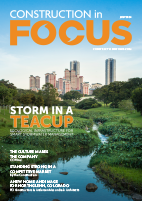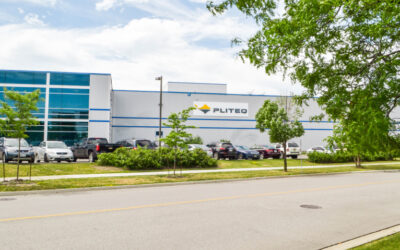Construction is a cyclical market. davisREED Construction Inc. knows that all too well – that to survive, a construction company must adapt, evolve, and respond to market changes, utilizing all its knowledge and expertise if it is to sustain project excellence over nearly 20 years.
Established in 2002, davisREED is a general contractor operating from California, though projects have taken the team across the country. With its headquarters in San Diego and offices in Los Angeles, Sacramento, Palm Desert, and Napa, its diversity is its strength and the reason it continues to overcome market ebbs and flows.
Despite enduring two major recessions, davisREED remains competitive: it has the talent and the experience to service both the private and the public sectors with projects in hospitality, commercial office, public works, education, mixed-use and multi-family residential.
When the company got its start, through the good years between 2002 and 2007, it took full advantage of the hospitality boom that brought a number of four- and five-star projects its way, but the global financial crisis between 2007 and 2008 certainly had an impact. As a result, it moved away from private sector work in favor of public-financed projects between 2009 and 2014.
As happens in the market, the next two years saw the return of the private sector, and davisREED, quick on its feet, enjoyed newfound success in the hospitality, multi-family, and tech-end-user sectors with several renovation projects in addition to new construction projects.
Strength and growth
Between 2016 and the present, each of the geographic regions the company serves has remained strong. Leveraging this market potential, davisREED has found ways to grow both its market share and its physical footprint. In 2017 it was the eighth fastest-growing company in San Diego with over 500 percent revenue growth in three years and it entered the Napa market.
“Talking about growth, sometimes you’re diversifying but you’re not growing,” noted President Derek Davis. “You’re growing in different directions to maintain because things cycle, so as hospitality drops off, affordable housing picks up and you know design-build schools pick up. Office buildings and tenant improvement projects drop off. It’s all part of the cycle.”
Building on relationships established in Napa, in 2019 davisREED acquired Ledcor Group’s Napa office and expanded its team by 20 people, growing its capabilities and expertise to undertake projects at wineries, historical renovations, and other local work.
More recently, the COVID pandemic posed a unique set of challenges for the company, as it did for every other business across sectors and geographies. The most important was obviously compliance related to ensure that company people were safe and its projects safeguarded.
Davis explains what the main issues and outcome were: “Operational issues, execution in the field, health and safety, regulations, process, tracing, temperature testing – in construction, people in the field are used to working in an environment of lots of OSHA rules and regulations. So once proper procedures were established, people fell in line and the process was efficient and there was excellent compliance.” For him, the company’s success was due to a combination of being lucky and having good processes.
Unfortunately, for davisREED and the market as a whole, the challenges stemming from COVID didn’t stop there, as supply chain constraints and project viability threatened existing and future projects, especially from a financing perspective.
“We had two projects that were affected much like in 2008 when Lehman went down and the rug was just ripped from underneath the projects,” Davis says. “We started one project in January and just a couple months into it, it was suspended. It takes a while to right the ship and turn in another direction. It’s not like $80 million projects grow on trees.”
Window of opportunity
As it typically does, when the private sector doors close, a public sector window opens and again, davisREED was able to pivot and take advantage of market opportunities which presented themselves in the affordable housing sector as well as branded residential.
“There’s already a pretty formative movement into affordable housing in California, and another resource associated with the product is the distribution of tax credit financing. We’ve had several projects that we’ve been working on in affordable housing in both northern and southern California, so that’s a pretty active sector and has been a lot of infill,” Davis notes.
“Affordable housing projects that we’ve done in the past were actually for redevelopment agencies as opposed to development or affordable housing group. So we didn’t have as much of a client base in that product type because the types of projects we executed before were delivered completely differently. They were redevelopment agencies, city projects, and a mixture of different capital stacks.” All this naturally led to davisREED expanding its base.
There is also activity in the branded hospitality market with players like Ritz Carlton, Four Seasons, Auberge, and other brands that have product for sale as part of their hospitality projects, which has seen an uptick thanks to the strength of the residential market.
The strength of the multi-family and single-family home residential market is very hot on top of COVID supply chain issues causing unique challenges in the delivery of this product. “In addition to the cost increases that we endured in dimensional lumber, stranded materials, plywood and OSB materials, for instance, is the matter of their availability,” says Davis of the difficult supply challenges associated with COVID.
“So just because you’ve got some material locked in at a material price that you can live with, or whatever the case may be, it doesn’t mean that you would get it, so there was always another shoe to drop due to allocations within the various market sectors,” says Davis. “We, for example, had to send dedicated trucks to retrieve existing inventory materials at pre-fabrication framers in Oregon, to ensure timely delivery of materials.”
The place of prefabrication
Prefabrication is not a new approach for davisREED Inc. In fact, prefabrication projects have been a part of the company’s background for many years, leveraged in the early 2000s on projects like the Carlsbad Sheraton and the Desert Willow Residential project, as well as several design-build projects for the Los Angeles Unified School District.
“Hospitality projects, as well as multifamily, including affordable, lend themselves to prefabrication because of repetitive units in a large enough baseline volume.” Davis adds that the market is still in an immature state, and despite some failures, he feels that it is a viable delivery process in both wood-framed and metal gauge building systems. davisREED is dedicated to this delivery process for the next cycle of projects.
While Davis notes that there may be a stigma associated with prefabrication and its tendency to look a certain way, with entitlements, planning department approvals, and design limitations, it is perfect for the affordable housing movement, especially in the context of COVID, supply chain restraints, and labor shortages.
According to Davis, “That’s what is accelerating that marketplace – I think more so than it would have been – and we’re looking to have a couple of affordable housing projects and conventional multifamily projects that are in that category. So, as far as the future goes, that’s a feather you want in your cap.”
He also notes that davisREED was probably one of the largest purchasers of bathroom pods for hospitality projects a couple of years back and as the industry matures, that experience will be invaluable across the products and markets the company serves.
Diversity rules
For the future, there’s an expectation that davisREED will continue to diversify so as to remain agile and relevant in the market, whether that means market diversity, technological diversity, or diversity in building approach.
“I think staying in lock step with technology, as design evolves to comply with energy revisions and jurisdictional statute changes, is going to be a critical part of our services to the industry. As we move toward renewable energy, you’re going to have more of a movement toward not only self-contained energy generation but also efficiency of design,” Davis says.
Davis is referring to new legislation, like SB-100, that requires renewable energy and the move away from natural gas and other carbon forms to on-site generation of energy. This, however, will have a significant impact on the material selection and engineered power approaches in design and construction to ensure projects are in line with code changes.
“A big goal of ours,” says Davis, “is staying on the cutting edge in regard to design, and smart design, because to be a good builder and general contractor and partner who’s working hand-in-hand with the developer and the design team, you have to have a hybridized set of skills.”
This requires a deeply rooted understanding of the design, of materials, and of the integration of mechanical, electrical, and plumbing systems whether that be prescriptive or performance-based design to support Title 24 calculation models for all different building types.
“Sometimes,” Davis says, “I think market sector reversions might be even faster now than they’ve been in the past with new product types and code changes, and the energy policies that the State of California has. Other revisions include fire hazard-zone development criteria, which has also recently changed and is being applied to already submitted and approved projects. As veterans in the market, davisREED is prepared to adapt and serve its clients and design teams as a collaborative, informed, and experienced partner.
Diversity is the major strength of davisREED Inc. and the driving force behind its ability to repeatedly deliver project excellence. Diversity, Davis says, is also the foundation of its strong client relationships and the secret behind the company’s continued growth and success.













